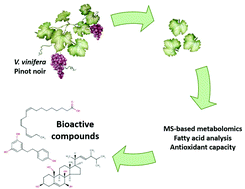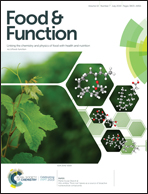Vitis vinifera ‘Pinot noir’ leaves as a source of bioactive nutraceutical compounds†
Abstract
Agricultural by-products are often hidden sources of healthy plant ingredients. The investigation of the nutritional values of these by-products is essential towards sustainable agriculture and improved food systems. In the vine industry, grape leaves are a bulky side product which is strategically removed and treated as waste in the process of wine production. In this work we performed an untargeted metabolomic profiling of the methanol extract of the leaves of Vitis vinifera cultivar ‘Pinot noir’, analysed their fatty acid content, and estimated their antioxidative capacity, with the purpose of investigating its nutritional and medicinal value. Fourier transform ion cyclotron resonance mass spectrometry (FT-ICR-MS) analysis identified the presence of numerous compounds which are known to possess diverse nutritional and pharmacological properties, particularly polyphenols and phenolic compounds (e.g. caffeic acid, catechin, kaempferol and quercetin), several phytosterols and fatty acids. Fatty acids were the most represented lipids’ secondary class, with the essential alpha-linolenic acid being the most abundant in ‘Pinot noir’ leaves, with a relative content of 42%. Also, we have found that ‘Pinot noir’ leaves present a high antioxidant capacity, putting grapevine leaves at the top of the list of foods with the highest antioxidative activity. Our findings scientifically confirmed that ‘Pinot noir’ leaves have a high content and diversity of biologically active phytochemical compounds which make it of exceptional interest for pharmaceutical and food industries.



 Please wait while we load your content...
Please wait while we load your content...